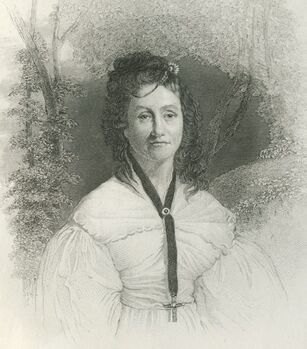
Maria Brooks (1794-1845), from Graham's Magazine 33, 1848. Courtesy Portraits of American Women Writers.
| Maria Gowen Brooks | |
|---|---|
| Born |
Abigail Gowen 1794 Medford, Massachusetts |
| Died | November 11, 1845 |
| Occupation | poet |
| Nationality |
|
Maria Gowen (or Gowan) Brooks (?1794 - November 11, 1845) was an American poet who wrote in a "florid and grandiose style."[1]
Life[]
Overview[]
Brooks was early married to a merchant, who lost his money, and left her a young widow, after which she wrote highly romantic and impassioned poetry. Her chief work, Zophiël; or, The bride of Swen, was finished under the auspices of Southey, who called her "Maria del Occidente," and regarded her as "the most impassioned and imaginative of all poetesses," but time has not sustained this verdict.[2]
Youth[]
Brooks was born Abigail Gowen in Medford, Massachusetts.[1] Her father was a man of literary tastes, and she was exposed to much poetry at home; by age 9, she had memorized a large quantity of prose. When Abigail was 13, her father died, bankrupt.
She immediately came under the care of a Boston merchant named John Brooks, a man more than 30 years older than she was, to whom she had already been betrothed. She finished her education and married him.
Career[]
For a while she and John lived prosperously, but "financial reverses" eventually reduced them to living in comparative poverty. Abigail began to write poetry as consolation. Around this time, she changed her name to "Maria Abigail", which would eventually become, simply, "Maria". Also around this time, at age nineteen, she had written her first epic poem. It is described as a "metrical romance", which she never published.
In 1820, Brooks published a collection of her poetry, Judith, Esther, and other poems, under the pseudonym "A Lover of Fine Arts". In 1823, her husband died, and she went to live with her brother on his coffee plantation in Manzanas, Cuba. He died soon after her arrival, which left her with a "settled income". During this time, she began to write the poem she would become most famous for: Zophiël, or the Bride of Swen, based on the story of Sara in the Book of Tobit.
In 1824, Maria made a sojourn to Canada, where she engaged herself to a Canadian soldier she had met in New England (prior to John Brooks’ death). However, they became estranged, "through a series of misunderstandings", and Ms. Brooks subsequently attempted suicide, twice. Upon returning to the United States, in 1825, she published the first canto of Zophiël in Boston.
In 1826, Brooks began a correspondence with the English Poet Laureate, Robert Southey, who praised her work heartily and gave her the pseudonym "Maria Del Occidente" (Maria of the West). He regarded her as "the most impassioned and imaginative of all poetesses",. She also caught the attention of Edgar Allan Poe. He, too, praised her work, and often mentioned her favorably in his literary reviews.
Maria finished Zophiël in 1829, but did not publish it immediately. First, she took her son, Horace, to Hanover, New Hampshire, to try to enroll him at West Point. She was unsuccessful. However, in the same year she visited Paris, and there met the Marquis de Lafayette, a man renowned for his heroic service in the American Revolutionary War. He was easily able to secure a position at West Point for Ms. Brooks’s son, who went on to be modestly successful there.
In 1831, she went to England and spent a few weeks at Robert Southey’s home. There, he oversaw the publishing of Zophiël in London. She then returned to the United States and lived in New England for approximately 12 years. In 1843 she serially published a "prose account of her unhappy love affair", called Idomen; or, the Vale of Yumuri, in a Boston newspaper. In December of the same year, she returned to her Cuban estate and published another poem, Ode to the Departed.
She died in 1845, at age 51, of tropical fever. She had been working on a romance at the time, Beatriz, Beloved of Columbus, which was never published.
Publications[]
Poetry[]
- Judith, Esther, and other poems (by "A Lover of the Fine Arts"). Boston: Cummings & Hilliard, 1820.
- Zophiel: A poem. Boston: Richardson & Lord, 1825.
- Zophiel, or The bride of seven. Boston: Lee & Shepherd / New York: C.T. Dillingham, 1879.
Non-fiction[]
- Idomen, or the vale of Yumuri. New York: Samuel Colman, 1843.
Except where noted, bibliographical information courtesy WorldCat.[3]
See also[]

Idomen, or The Vale of Yumuri Maria Gowen Brooks Fictional Biographies & Memoirs 3 4
References[]
- J. D. Grove, ‘Legacy Profile: Maria Gowen Brooks (c.1795-1845)’, Legacy, 12 (1995): 38-46
- Dennis Low, The Literary Protégées of the Lake Poets (Aldershot: Ashgate, 2006)
- Ruth Shepard Graniss, An American Friend of Robert Southey (New York: [privately published], 1913).
Notes[]
- ↑ 1.0 1.1 Maria Gowen Brooks, Encyclopædia Britannica, Encyclopædia Britannica Inc. Web, July 13, 2013.
- ↑ John William Cousin, "Brooks, Maria," A Short Biographical Dictionary of English Literature, 1910, 48. Web, Dec. 20, 2017.
- ↑ Search results = au:Maria Gowen Brooks, WorldCat, OCLC Online Computer Library Center Inc. Web, July 14, 2013.
External links[]
- Poems
- About
- Maria Gowen Brooks in the Encyclopædia Britannica
- Maria Brooks in Portraits of American Women Writers
| This page uses Creative Commons Licensed content from Wikipedia. (view article). (view authors). |
|